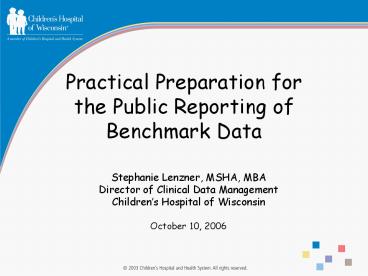Practical Preparation for the Public Reporting of Benchmark Data - PowerPoint PPT Presentation
1 / 18
Title:
Practical Preparation for the Public Reporting of Benchmark Data
Description:
WebMD Quality Services. Regional/Payer Examples ... Quality and patient safety measures on web site. Simulation in preparation of negative publicity ... – PowerPoint PPT presentation
Number of Views:140
Avg rating:3.0/5.0
Title: Practical Preparation for the Public Reporting of Benchmark Data
1
Practical Preparation for the Public Reporting
of Benchmark Data
- Stephanie Lenzner, MSHA, MBA
- Director of Clinical Data Management
- Childrens Hospital of Wisconsin
- October 10, 2006
2
Presentation Highlights
- Approach to benchmarking
- Interpretation of public reporting
- Practical preparation
- What is CHW doing?
- How are we doing it?
- Recommendations and next steps
3
CHWs Approach to Benchmarking
- Benchmark where and when we can
- Against ourselves
- Against the evidence
- Against pediatric peers
- National and local agencies/payers (including
adults) - If we want to eliminate or increase do not
waste resources to determine a benchmark when the
ultimate goal should be 0 or 100
4
CHWs Approach to Benchmarking
- Measure clinical programs and develop measures
across the 6 dimensions from IOM - Safe, Effective, Efficient, Equitable, Patient
Centered and Timely - Collaborate with clinicians and families for
interpretation and recommendations - Transparency is key
- Definitions and assumptions
- Appropriate display and interpretation
- Results internally and externally
5
Interpretation of Public Reporting
- Means a lot of different things to a lot of
different people - It is complicated, confusing and conflicting
- Roles are blurred
- It is emotional and political
- Stakes are high
6
Interpretation of Public Reporting
- Wide variation in the methods used to summarize
hospital and physician performance - Variation can lead to significantly different
conclusions - Voluntary and mandated participation
7
Who Cares?
- We all should
- Responsibility to inform consumers of value, not
just low cost options (quality/safety and cost) - Impacts contracting, accreditation and
certification - Poor presentation could negatively impact
finances, market share and reputation
8
National Examples
- Agency for Healthcare Research and Quality (AHRQ)
Indicators - http//www.qualityindicators.ahrq.gov/
- Leapfrog Hospital Quality and Safety Survey
http//leapfroggroup.org/ - Healthgrades Physician and Hospital Information
http//www.healthgrades.com/consumer/ - JCAHO Quality Check http//www.qualitycheck.org/
- CMS Hospital Compare http//www.hospitalcompare.hh
s.gov/
9
National Examples
- HospitalWise Professional Medscape
http//www.medscape.com/pages/features/hospitalcom
pare/hospitalcompare - Hospital Victims http//www.hospitalvictims.com/hv
_hosp_main.asp?mpn523300 - Subimo http//subimo.com/
- Healthia http//www.healthia.com/
- WebMD Quality Services
10
Regional/Payer Examples
- Quality Counts (the Alliance) http//www.allianceh
ealthcoop.com/ - Checkpoint (WHA) http//www.wicheckpoint.org/
- Pricepoint (WHA) http//www.wipricepoint.org/
- Wisconsin Collaborative for Healthcare Quality
http//www.wiqualitycollaborative.org - Humana Business Group Coalition
- United Healthcare Definity Health Plan
11
What is CHW doing?
- Created a data management program
- Data quality assurance prior to release
- Proactively survey publicly reported data
- Work actively with reporting organizations
- Develop meaningful quality measures internally
and collaborate with pediatric peers externally - Participate in Nationally recognized benchmarking
programs (NACHRI)
12
How are we doing it?
- Created a data management program
- Needs assessment
- Restructured and expanded resources accordingly
- Developed database to log requests and monitor
future needs - Involved families in measurement process
- Created a physician advisory panel
- Created an online clinical data request process
- Proactively managed expectations (customers
including physicians, leaders, staff)
13
How are we doing it?
- Data quality assurance prior to release
- Needs assessment
- Inventory of existing data sources
- Critical review of data integrity
- Development of edits prior to submission to
state/Solucient - Process improvement on data collection/entry,
interrater reliability, data definitions
(negative days of px)
14
How are we doing it?
- Proactively surveying our reported data
- Created dynamic document of publicly reported
data - Regularly updated
- Presentations at Medical Leadership
- Reported semi-annually to Council for Quality
- Helped drive resource allocation and engaged
leadership - Catalyst for conversations with reporting
entities
15
How are we doing it?
- Working with reporting organizations
- Provide feedback based on reported or proposed
reported data - Includes data sources, populations, definitions,
formulas and risk adjustment - Find a way to be at the table with reporting
agencies - Relationships
- Expertise and willingness to provide alternatives
- Attendance at local/regional/national meetings
16
How are we doing it?
- Developing quality measures internally and
collaboratively externally - Goal is to provide options and alternatives
- Transparency of internal measures (those publicly
reported should be no different) - Creates opportunity to engage physicians and
hospital leaders - Participation in measure review/validation
- Collaboration with AHRQ, NACHRI, CHCA, ABP, AAP
- Alliance, Definity Health Plan
17
Next steps
- Refinement of data management process (PDSA)
- Working with IS to design and build future data
tools - Build measures into Decision Support System
- Prepare for physician specific reporting and P4P
- Enhance relationship with PR
- Quality and patient safety measures on web site
- Simulation in preparation of negative publicity
- Continue collaboration with pediatric partners
18
Thank you!































